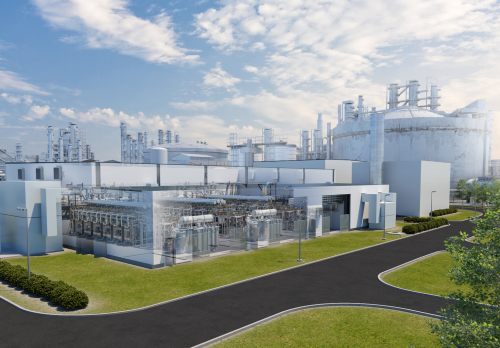With an output of 54 MW and a capacity of up to 8,000 metric tons of hydrogen per year, the PEM electrolyzer will be one of the largest of its kind in Germany once it is operational. Powered using electricity from renewable energy sources, the system will produce CO2-free hydrogen and thereby reduce greenhouse gas emissions at the site by up to 72,000 metric tons annually.

Illustration of the future water electrolysis plant integrated at the BASF site in Ludwigshafen. Copyright: Siemens Energy
BASF will primarily use this hydrogen as a raw material in the manufacture of products with a reduced carbon footprint. In addition, the company will supply hydrogen for mobility in the Rhine-Neckar Metropolitan Region to support the ramp-up of a hydrogen economy in the area.
BASF and Siemens Energy plan to begin operating the water electrolysis plant in 2025. In cooperation with the State of Rhineland-Palatinate, the German Federal Ministry for Economic Affairs and Climate Protection is contributing up to €124.3 million to the project—up to €37.3 million of which will be financed by the government of Rhineland-Palatinate.
Hydrogen is the starting point for important chemical value chains. At the Ludwigshafen site, the company uses around 250,000 metric tons per year, which are produced by means of steam reforming or occur as coupling products and by-products.
Steam reforming, the current conventional production process, generates high CO2 emissions. Changing the technology for producing hydrogen and using this hydrogen as a raw material for chemical products should significantly reduce BASF’s carbon footprint. In order to drive the ramp-up of the hydrogen economy, BASF is committed to remaining as open as possible toward different technologies for the production of low-emission or emission-free hydrogen. Besides water electrolysis, such options also include methane pyrolysis.
BASF has set itself the target of achieving net zero CO2 emissions by 2050. The use of renewable energies, an increase in energy efficiency in production, and new technologies will support this objective. The Ludwigshafen site has a key role to play: Numerous technologies are being tested and developed at the company’s headquarters with the aim of replacing fossil fuels and using renewable electricity instead. In addition to water electrolysis, examples include the demonstration plant for electrically heated steam cracker furnaces and a methane pyrolysis test plant.